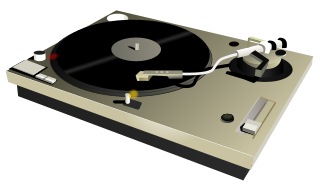
A record player, also called a turntable and historically known as a phonograph or gramophone, is a device for the mechanical and analogue reproduction of recorded sound. The sound vibration waveforms are recorded as corresponding physical deviations of a spiral groove engraved, etched, incised, or impressed into the surface of a rotating cylinder or disc, called a "record". To recreate the sound, the surface is similarly rotated while a playback stylus traces the groove and is therefore vibrated by it, very faintly reproducing the recorded sound. In early acoustic phonographs, the stylus vibrated a diaphragm which produced sound waves which were coupled to the open air through a flaring horn, or directly to the listener's ears through stethoscope-type earphones.

Phonograph cylinders are the earliest commercial medium for recording and reproducing sound. Commonly known simply as "records" in their heyday, a name which has been passed on to their disc-shaped successor, these hollow cylindrical objects have an audio recording engraved on the outside surface which can be reproduced when they are played on a mechanical cylinder phonograph. The first cylinders were wrapped with tin foil but the improved version made of wax was created a decade later, after which they were commercialized. In the 1910s, the competing disc record system triumphed in the marketplace to become the dominant commercial audio medium.

The Victor Talking Machine Company was an American recording company and phonograph manufacturer, incorporated in 1901. Victor was an independent enterprise until 1929 when it was purchased by the Radio Corporation of America (RCA) and became the RCA Victor Division of the Radio Corporation of America until late 1968, when it was renamed RCA Records.

Berliner Gramophone – its discs identified with an etched-in "E. Berliner's Gramophone" as the logo – was the first disc record label in the world. Its records were played on Emile Berliner's invention, the Gramophone, which competed with the wax cylinder–playing phonographs that were more common in the 1890s and could record.

Leeds Talk-O-Phone was a record label, producing cylinders from 1894 to 1903 and single-sided lateral-cut disc phonograph records in the United States of America from about 1902 to 1909.

Emile Berliner originally Emil Berliner, was a German-American inventor. He is best known for inventing the lateral-cut flat disc record used with a gramophone. He founded the United States Gramophone Company in 1894; The Gramophone Company in London, England, in 1897; Deutsche Grammophon in Hanover, Germany, in 1898; and Berliner Gram-o-phone Company of Canada in Montreal in 1899. Berliner also invented what was probably the first radial aircraft engine (1908), a helicopter (1919), and acoustical tiles (1920s).
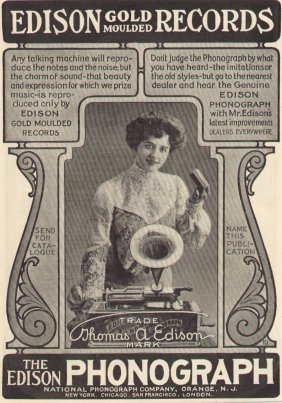
Edison Records was one of the early record labels that pioneered sound recording and reproduction, and was an important and successful company in the early recording industry.

Blue Amberol Records was the trademark name for cylinder records manufactured by Thomas A. Edison, Inc. in the US from 1912 to 1929. They replaced the 4-minute black wax Amberol cylinders introduced in 1908, which had replaced the 2-minute wax cylinders that had been the standard format since the late 1880s. Blue Amberols can play for as long as 4 minutes and 45 seconds and have a surface layer of the "indestructible" plastic celluloid, which Edison tinted a trademark blue color. Edison brand phonographs designed to play Amberol cylinders were named Amberolas.
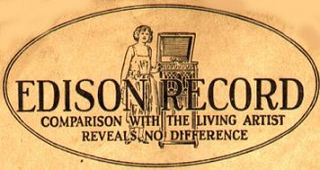
The Edison Diamond Disc Record is a type of phonograph record marketed by Thomas A. Edison, Inc. on their Edison Record label from 1912 to 1929. They were named Diamond Discs because the matching Edison Disc Phonograph was fitted with a permanent conical diamond stylus for playing them. Diamond Discs were incompatible with lateral-groove disc record players, e.g. the Victor Victrola, the disposable steel needles of which would damage them while extracting hardly any sound. Uniquely, they are just under 1⁄4 in thick.

The Graphophone was the name and trademark of an improved version of the phonograph. It was invented at the Volta Laboratory established by Alexander Graham Bell in Washington, D.C., United States.

Sound recording and reproduction is the electrical, mechanical, electronic, or digital inscription and re-creation of sound waves, such as spoken voice, singing, instrumental music, or sound effects. The two main classes of sound recording technology are analog recording and digital recording.

George J. Gaskin was one of the most popular singers in the United States during the 1890s and an early American recording artist.

Eldridge Reeves Johnson was an American businessman and engineer who founded the Victor Talking Machine Company in 1901 and built it into the leading American producer of phonographs and phonograph records and one of the leading phonograph companies in the world at the time. Victor was the corporate predecessor of RCA Records.

Daniel William Quinn was one of the first American singers to become popular in the new medium of recorded music. Quinn was a very successful recording artist whose career spanned from 1892 to 1918. Quinn recorded many of his hits in the legendary Tin Pan Alley of New York City.

A dictation machine is a sound recording device most commonly used to record speech for playback or to be typed into print. It includes digital voice recorders and tape recorder.

The Volta Laboratory and the Volta Bureau were created in Georgetown, Washington, D.C., by Alexander Graham Bell.
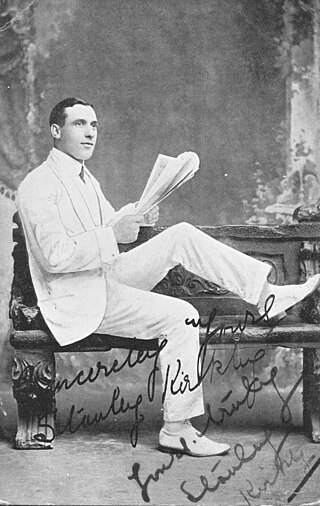
Stanley Kirkby was an English baritone singer and variety artist of the early 20th century. He sang ballads and popular songs of the Edwardian era, the First World War and the inter-War period. He sang mostly in music halls and variety theatres and was a popular recording artist.
Edison Bell was an English company that was the first distributor and an early manufacturer of gramophones and gramophone records. The company survived through several incarnations, becoming a top producer of budget records in England through the early 1930s until, after it was absorbed by Decca in 1932, production of various Edison Bell labels ceased.

Charles P. Lowe was an American xylophonist who made numerous recordings in the early days of the recording industry.
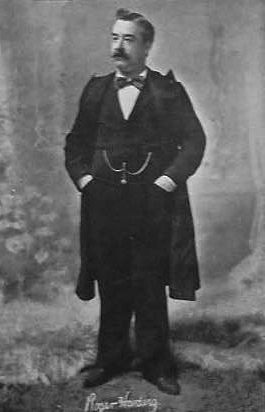
Roger Harding was an American singer, composer and music publisher active in the United States from 1890 to 1901.



















